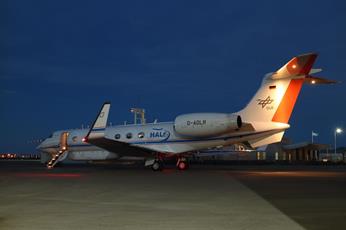Facebook

The German research aircraft HALO will explore the southern hemisphere as part of the SouthTRAC (Transport and Composition of the Southern Hemisphere UTLS) project in September and November 2019. Data from the southern hemisphere is crucial to our understanding of how climate change is influencing global atmospheric flows. However, as yet almost no measurements have been taken in the southern hemisphere at altitudes of 10 to 15 kilometers. The SouthTRAC project aims to fill these gaps in our understanding. The main goals of the first phase of this campaign are to investigate ozone depletion over the Antarctic in springtime, the so-called ozone hole, and to evaluate the importance of gravity waves over the southern tip of the Americas and the Antarctic to the circulation in the stratosphere. [...] Trace gases such as carbon dioxide and water vapor are potent greenhouse gases and play an important role in climate change. This also includes stratospheric ozone, which acts as a greenhouse gas. Since the end of the 1980s, the Montreal Protocol has banned the use of chlorofluorocarbons (CFCs), which severely deplete the ozone layer. However, it will take many decades for the ozone layer to recover. At the same time, climate change is affecting the water vapor content of the atmosphere. The SouthTRAC campaign scientists are currently looking in detail at the significance of this for the chemical composition of the air in the southern hemisphere and for global climate change. A particularly region of severe ozone depletion is building up year by year over the Antarctic. The atmospheric conditions that contribute most to ozone depletion over the Antarctic are low temperatures and reduced air mass exchanges between mid and high latitudes in the stratosphere. The latter are enabled by a stable vortex, the so called Antarctic polar vortex. The research groups involved are interested in polar ozone depletion itself and in the question of how air masses from the vortex affect the composition of the region at altitudes of 10 to 15 kilometers. This region is also of particular significance to the climate at ground level. Water vapor and ozone play key roles here, as their distribution directly influences the energy balance of the atmosphere. In addition to the effects of polar ozone chemistry, emissions from forest fires in the Amazon and Central Africa interfere with the chemical processes on the ground which determine the production and destruction of ozone and other substances. The scientists will analyze the chemical as well as the dynamic effects that impact the distribution and mixing of substances affecting atmospheric chemistry and ultimately earth's climate. [...] Eurekalert, 26 September 2019, By: Johannes Gutenberg Universitaet Mainz